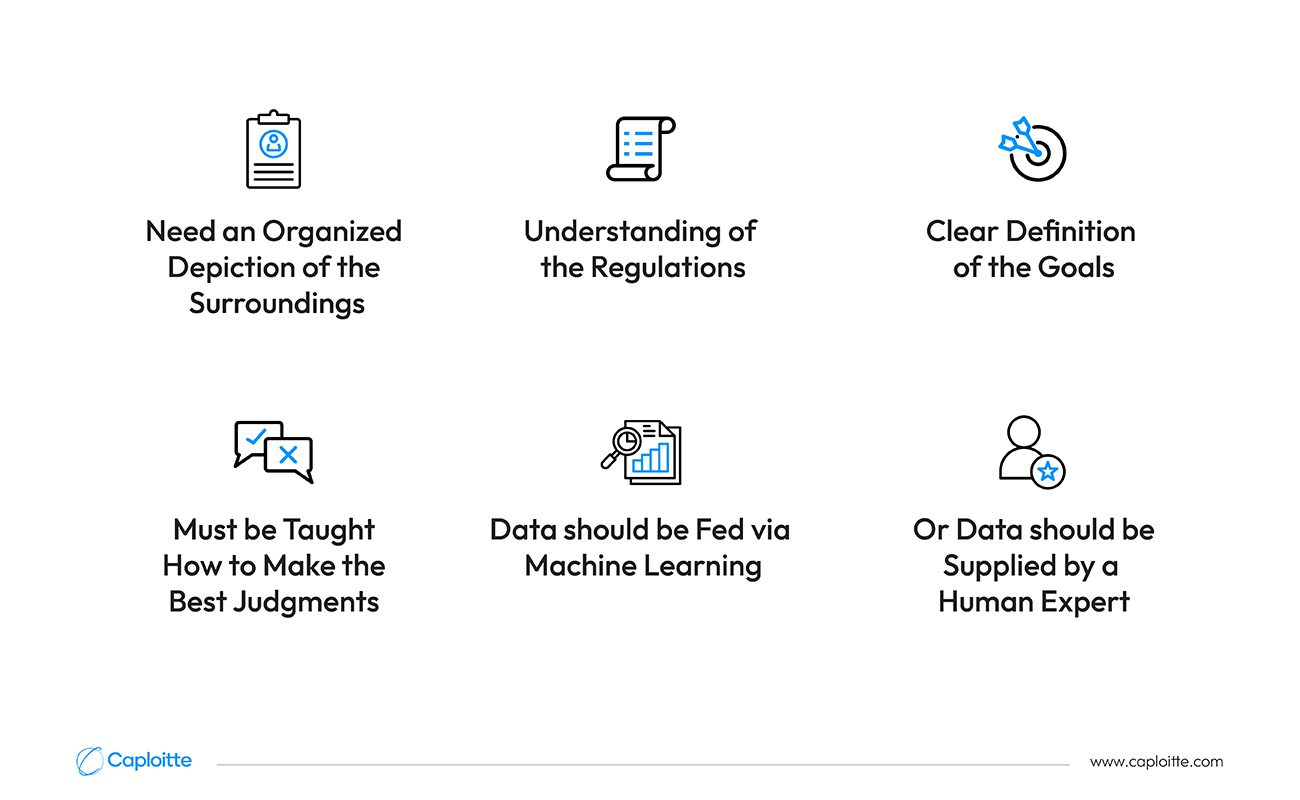AI in Financial Forecasting and Risk Management
-
Caploitte
-
13 May 2024
-
04 Min Read
What is the evaluation of financial risk?
Understanding Artificial Intelligence for Financial Risk Management
AI and the impact of financial complexity
Artificial Intelligence in the Financial Sector
AI’s advantages and prospects for financial risk management
Main Obstacles and Things to Think About
Conclusion
Risk assessment has long served as the sentinel preventing possible financial disasters in the enormous financial industry. Artificial intelligence (AI) has become a potent instrument that can completely transform financial risk management procedures thanks to the quick development of technology. At the vanguard of this revolution is the financial services sector, and specifically the banking industry, which is utilizing cutting-edge technology like artificial intelligence (AI) and machine learning (ML) to cut down on fraud, create new efficiencies, and improve customer service.
With their sophisticated prediction methods and capacity to process massive amounts of data, AI and ML technologies are being utilized more and more in risk management to enable faster and more effective decision-making in the areas of credit, investments, and business. The potential and difficulties of using AI in financial risk management are examined in this article.
What is the Evaluation of Financial Risk?

Evaluating the likelihood and consequences of a negative financial occurrence is known as financial risk assessment. This might be anything from a straightforward loan payment default to intricate swings in the world capital markets. By ascertaining the probability of those occurrences, establishments can be ready for, steer clear of, or even capitalize on these hazards.
Understanding Artificial Intelligence for Financial Risk Management

Risk management systems driven by AI provide unmatched advantages, paving the path for greater accuracy and efficiency. When discussing financial risk management, artificial intelligence refers to a variety of cutting-edge technologies including machine learning, natural language processing, and predictive analytics. These advanced artificial intelligence-powered risk management solutions are essential for businesses looking to quickly assess possible hazards and make well-informed choices. Financial institutions may improve risk detection, assessment, and mitigation with the use of these strategies.
Businesses can anticipate and plan for a range of risk situations thanks to AI’s predictive analytics and data-driven insights, which dramatically lower the possibility of unforeseen setbacks. Businesses that use AI are not only reducing risks more successfully but also establishing new standards for risk management procedures, staying ahead of the curve in an unpredictable environment.
AI and the Impact of Financial Complexity

The vast scope of artificial intelligence (AI) research precludes a straightforward description. The tasks AI is expected to complete need an organized depiction of the surroundings, an understanding of the regulations that must be adhered to, and a clear definition of the goals that must be met. Although artificial intelligence (AI) is associated with algorithmic behavior, machine learning (ML) is a keystone of most AI applications. The process of learning about the environment that the AI engine is supposed to be in charge of is known as machine learning.
The AI must be taught how to make the best judgments if it is to function independently. This needs knowledge about the environment’s structure, which can be derived from data via machine learning (ML) or supplied by a human expert. However, AI also needs well-defined goals for its activities to accomplish. The AI can then take action after being provided a representation of its work environment and goals. Most applications use reinforcement learning, which combines exploration and exploitation with dynamic programming approaches to teach the AI the state-contingent link between its actions and the resulting payoffs, to educate it to make optimum decisions.
The AI engine must be equipped with a more complex theory of mind for the majority of strategic scenarios, which entails an internal representation of adversaries’ goals and worldviews that go beyond viewing them as simply copies of the AI.
Algorithms are fallible when it comes to making judgments. Algorithmic bias results from systematic errors made by the AI, which cause incorrect internal representations to skew decision-making away from the intended result. AI makes poor judgments for a variety of reasons. It may have received inaccurate data, which caused the AI to reproduce bias or human mistakes in a task requiring supervised learning.
Clearly defining the goals of AI when it comes to decision-making in intricate social contexts is one of the most difficult issues. A precise objective function that assesses the costs and advantages of different courses of action in light of the environment’s current state and how it will change in the future as a result of the actions selected must be provided for the algorithm. Making poor judgments is inevitable when the problem’s structure is not well specified.
Artificial Intelligence in the Financial Sector

The financial sector is transforming due to the capacity to gather vast amounts of data from the environment and apply machine learning and artificial intelligence (ML) to interpret it, here let’s discuss some prevalent sectors:
1. Forecasting
The financial industry uses AI/ML systems to satisfy consumer needs, process payments, anticipate macroeconomic and financial factors, and keep an eye on company situations. Although there are advantages to using AI/ML in predicting, there are drawbacks as well. Similarly, unstructured data can be included in the forecasting process with artificial intelligence (AI) and natural language processing (NLP). The use of unconventional data in financial forecasting, however, brings up several issues, including the legal and regulatory framework that governs it, the consequences for ethics and privacy, and the quality of the data in terms of cleanliness, correctness, relevance, and potential biases.
2. Management of Risk and Compliance
Recent developments in AI and ML are altering the use of technology and its function in regulatory compliance. The global financial crisis of 2008 led to regulatory tightening and increased compliance costs, which has increased the significance of regulatory technology. Growing AI/ML technology may encourage more regtech use in the banking industry. These include identity verification, handling risks, identifying fraud, stress assessments, micro- and macroprudential reporting, anti-money laundering/fighting the funding of terrorism, and compliance with COVID-19 relief criteria.
3. Investment and Banking Services
The investment management sector has been the most affected by recent advancements in AI/ML in the financial sector. However new players in the market, improved analytics and decision-making techniques, and cost savings through automated procedures are all changes brought about by AI/ML and associated technologies. The use of machine learning and artificial intelligence in banking has progressed more slowly than in the asset management sector. Historical leadership in technology has been shown in the banking sector. The availability of vast amounts of timely, high-quality data is a prerequisite for the application of AI/ML in banking and investing. Explaining the reasoning behind AI/ML-based financial choices is becoming a more significant problem as these algorithms may find unforeseen connections in data sets that stakeholders may find difficult to comprehend due to unknown underlying causality.
4. Central Banking
Applications of AI/ML might assist central banks in fulfilling their tasks, notwithstanding their slow adoption of these technologies. AI/ML technologies can assist central banks in better understanding economic and financial events, improve their operational efficiency, and allow more accurate monetary and macroprudential policies. Furthermore, central banks may benefit from increased productivity and better internal control opportunities brought about by AI/ML, such as the capacity to oversee internal operations and distribute resources among different projects. Currently, it doesn’t seem like there are many issues with AI/ML in central banking, but this might change when the technology is applied more extensively. Additionally, central banks may have challenges in obtaining representative and high-quality data due to privacy and data security issues. If the central bank lacked the resources and expertise required to appropriately manage and use AI/ML threats, these concerns would grow.
AI’s Advantages and Prospects for Financial Risk Management

Artificial Intelligence (AI) in financial risk management offers several advantages and prospects. The financial industry is always open to a range of dangers, the most prevalent of which are as follows:
1. Medication Safety
The pharmaceutical sector is seeing a revolution in medication safety through the use of AI in risk management. Artificial Intelligence detects possible bad medication responses before they become significant by evaluating large datasets. Examples of artificial intelligence being used in the pharmaceutical industry for risk management include trial results and patient appropriateness prediction. AI is capable of tracking real-world data once a medicine is released. This provides continuous monitoring and safety, identifying potential hazards that may not have been evident during clinical studies. The predictive analysis provided by AI is essential for averting medical crises and guaranteeing patient welfare. The use of AI in medication risk management is a significant advancement in public health and safety.
2. Credit Threat
Repayment of loans or credit lines on schedule and in full is critical to a bank’s profitability. To provide a customized risk score, these models and neural networks take into account a wide range of inputs, including the borrower’s current assets, past behavior data, personal information, and outside variables and trends that can affect their capacity to repay a loan. Artificial intelligence-enabled credit risk management solutions fully investigate the borrower’s legitimacy and credit history and identify any early indicators of non-payment.
3. Fraud detection
Banks can find irregularities and anomalies in loan applications with the use of machine learning algorithms. Given the current state of digital transactions, manual fraud detection systems, which heavily rely on human analysts, are neither practicable nor effective for keeping up with the rate of growth in digital transactions. Over time, the AI or ML model will get smarter in both loan fraud detection and transaction fraud detection.
4. Preventing Threats
To spot early indicators of fraud, insider trading, data theft, and other financial crimes and wrongdoings, traders’ and other financial professionals’ activities are monitored using AI and associated techniques and technology. To discover and notify the business of possible hazards and wrongdoing, AI-enabled systems may log, monitor, and analyze email traffic, phone logs, time cards, and vacation calendars.
5. Compliance with Anti-Money Laundering (AML)
The use of AI in risk management has greatly improved activities related to anti-money laundering (AML). AI is used by financial organizations to examine transaction patterns for unusual activity. AI’s function in risk management, particularly in AML, is to increase detection speed and accuracy. It evaluates customer profiles for possible danger indicators by comparing them to international databases. AI is used in client due diligence as part of corporate risk management for AML. Background checks are automated, which speeds up onboarding while maintaining compliance. AML compliance depends on continual due diligence, which is supported by AI’s real-time monitoring.
6. Analysis of Market Risk
Market risk analysis is changing as a result of AI-powered risk management. Large volumes of market data are processed by AI systems, which find tiny patterns that people would miss. The capacity of AI to analyze vast information contributes to a more profound comprehension of market dynamics. The insights provided by AI provide investment businesses with a competitive advantage. They can foresee hazards and modify portfolio strategies appropriately. In turbulent markets, AI’s real-time analysis enables quicker, more informed decision-making. The use of this technology is essential to current financial risk management techniques.
2. Put offline support and caching into practice.
PWA features like caching and offline support are crucial since they let your app function even in the event of a faulty or unavailable network. Your PWA will include offline support and caching implemented via service workers, a JavaScript script that runs in the background and intercepts network requests.
3. Make fonts and graphics more optimized.
Since images and fonts are frequently the biggest and priciest assets in your PWA, optimize them to lessen their negative effects on the application’s speed and loading time. Use font subsetting, scaling, format conversion, compression, or lazy loading to carry this out.
4. Reduce the size and weight of your code.
Code compression and minification entail cutting extraneous letters and spaces, abbreviating variable names, and minimizing code size. As a result, less data will need to be sent over the network, which will enhance PWA performance and loading times.
5. Evaluate and track your performance.
Your PWA’s loading speed and user experience may be negatively impacted by problems or bottlenecks, which can be found and fixed by measuring and tracking your performance.
Main Obstacles and Things to Think About
Even though AI has a lot of promise, there are issues and factors to take into account when implementing it in financial risk management. The availability and quality of data are critical components since training AI models successfully need accurate and pertinent data. The concern is that economic policies or market strategies based on these models may be difficult for relevant counterparties to interpret or predict due to difficulties in model interpretation, analytical power sustainability, and model prediction. This could lead to additional asymmetric information in the market and unclear effects on financial stability. Another issue is model interpretability, as AI algorithms can occasionally yield complicated and ambiguous results that need extra work to assure compliance and transparency. The ethical implications of data security and privacy must also be taken into account when applying AI to risk management.
Conclusion
To sum up, artificial intelligence plays a revolutionary rather than merely transformational function in financial forecasting. The relationship between AI and finance will only get stronger as technology develops, resulting in improved decision-making, simpler operations, and more precise projections. Adopting AI is the future for companies and investors, not merely a way to get a competitive edge. Because AI/ML technology and its applications in finance are still in their infancy, neither consumers nor developers nor providers of technology comprehend the entire range of the technology’s advantages and disadvantages at this time.
Share this post:
Read More
- All
- AI
- AR
- DevOps and CI/CD
- E-commerce
- FinTech
- IoT
- Mobile Development
- Outstaffing
- Security
- SEO
- Tech Trends
- Web Design
- Web Development




